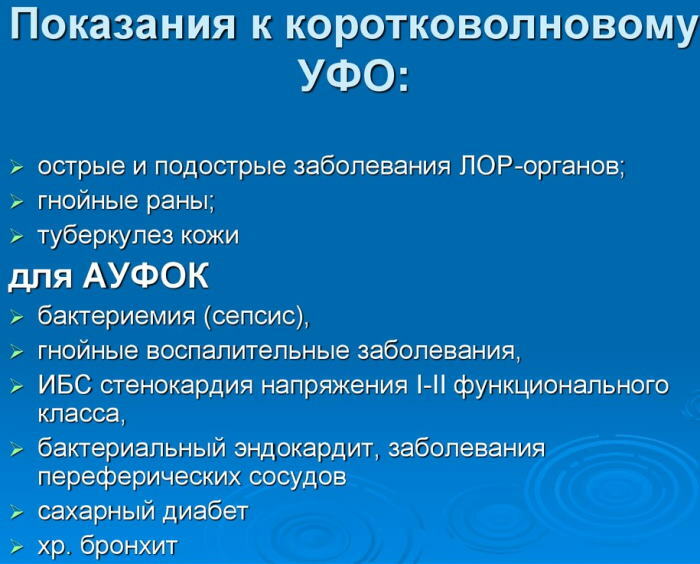Content
- Essence and basic principles
- Diet number 1 and its subspecies
- Diet number 5
- Indications
- With acute gastroduodenitis
- With chronic gastroduodenitis
- With exacerbation of gastroduodenitis
- With gastroduodenitis with high acidity
- With erosive gastroduodenitis
- With superficial gastroduodenitis
- With atrophic gastroduodenitis
- With pancreatitis and gastroduodenitis
- With gastritis and gastroduodenitis
- With gastroduodenitis and cholecystitis
- Contraindications
- Helpful hints
- Main menu
- Video about nutrition for stomach diseases
A healthy lifestyle and proper nutrition are the basic rules that can guarantee everyone a long life, in which communication with representatives of medicine will be minimized. However, if any problems arise, and nevertheless there is a need to seek qualified medical help, you need to do this immediately.
Each disease requires a timely response, as well as a clear plan of action that will help neutralize acute pain and eliminate symptoms. In addition to emergency treatment, it is generally recommended to stick to a certain lifestyle and diet, especially for stomach and intestinal problems.
Gastroduodenitis (inflammation of the stomach liningpassing to the intestine) is a pre-ulcer state of the body, therefore, during its treatment, it is required to adhere to a certain diet. There are 2 reasons for this disease.
The first lies in the increase in acid production, and the second - in the violation of hormonal regulation of secretion. Along with endogenous causes, an important role is played by secondary (exogenous) ones, which represent an irrational and unbalanced diet, excessive consumption of cold, hot, spicy food or foods with an increased amount of pesticides, which subsequently leads to inflammation of the mucous membrane of the duodenum and the pyloric zone stomach.
To mitigate the course of the disease and get rid of its negative consequences, you should adhere to a special diet. In combination with a well-designed course of treatment, it will allow you to forget about the manifestation of the disease.
Essence and basic principles
A diet for a sick stomach and intestines involves eating at a strictly defined time, at least 5-6 times a day. During these meals, the patient should diversify their diet in such a way as to get the maximum amount of nutrients. This will help you to recover sooner, as well as improve your health for a long time.
Thus, the diet for gastroduodenitis includes the most balanced diet, and the meal regimen is equated to a special and important ritual. Increased acid production and decreased mucus production requires regular and frequent meals. This helps to reduce acidity and protect the walls of the digestive system from the formation and development of ulcers. The food itself should be at a moderate temperature - not hot or cold.
The general recommendations on which the diet is based for gastroduodenitis look like this - meat, chicken and fish soups must be present in the diet. In addition, the body should receive dairy products and eggs, various cereals, vegetables and fruits. It is also recommended to use lean meat or poultry as a main course.
A diet for a diseased stomach excludes the use of foods such as strong broths of fish, meat, vegetables or mushrooms and soups on them, as well as fatty fish or meat.
The diet should be free from pickles and marinades, smoked meats and canned food. In addition, you cannot eat black bread and pastries, add a variety of sauces to dishes.
It is equally important to give up alcohol and carbonated drinks, black coffee, chocolate and ice cream, raw vegetables (especially radishes, cabbage, spinach, sorrel, radishes, onions and cucumbers), as well as some fruit.
The diet for gastroduodenitis has several variations.
Diet number 1 and its subspecies
Diet table number 1 is recommended for diseases of the stomach and duodenum, both during the exacerbation and in the recovery stage. In addition, it can be recommended for patients with acute gastritis or exacerbation of a chronic one.
Initially, diet number 1a is prescribed, in which the daily diet is no more than 1850 calories. The menu includes steamed or boiled liquid and puree dishes. It should be followed for about 2 weeks. After that, the patient needs to switch to diet No. 1b with a daily calorie content of 2600 calories.
As soon as the state of health improves significantly, table # 1 is applied. The diet of this diet still consists of foods that do not stimulate gastric secretion, but the menu is expanding significantly (allowed not only mashed potatoes, but also various cutlets, casseroles and lumpy dishes, boiled, baked or cooked in steamer).
Diet number 5
Gastroduodenitis often requires concomitant treatment not only of the duodenum and the stomach itself, but also of the liver and biliary tract. Therefore, in addition to the main table number 1, you must comply with the requirements of diet number 5. It involves reducing the consumption of refractory fats with a normal intake of proteins and carbohydrates. All foods are cooked by boiling and steaming, and tough meats and starchy vegetables are rubbed.
Therapeutic diet number 5 for gastroduodenitis excludes the use of fatty pork and beef, lamb and duck, lard and cooking fats. Also, it is not recommended to eat goose meat, offal, smoked meats and sausages, canned food, salted fish.
Diet for a sick stomach number 5 involves the preparation of lean meat and fish - veal, rabbit, lean pork, as well as chicken and turkey. All low-fat and soft varieties of fish are allowed.
When preparing dishes, it is allowed to use a little butter and refined vegetable oil, and cinnamon and vanillin can be added as seasonings.
From bakery products, exclude fresh bread, fried pies and puff cookies, rich flour products. You can add yesterday's bread and biscuits to the menu. From sweets, dried fruits and jellies, mousses and compotes, meringues and marmalade, lozenges, honey are allowed.
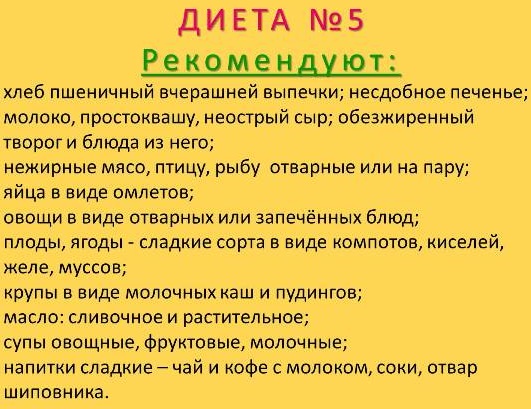
If you follow diet number 5, you can not eat cream and whole milk, fermented baked milk and homemade sour cream, salted and fatty cheese, but kefir and acidophilus, yogurt, cottage cheese and low-fat cheese - you can. It is allowed to add half an egg yolk per day to any food.
Preference should be given to soups and cereals. At the same time, when preparing the first courses, it is necessary to abandon the steep rich broth.
Indications
The diet for a sick stomach may differ, depending on the form and characteristics of the course of the disease. This can affect both the menu and the duration of the restriction.
With acute gastroduodenitis
The acute form of gastroduodenitis usually occurs with improper diet, namely, with a diet consisting mainly of dry and cold snacks, consumption of excessive amounts of alcohol and fatty foods, hobby for smoked and canned foods, as well as carbonated drinks.
It is also important to know that stomach and intestinal diseases can develop as a result of the constant ingestion of too hot or cold food. It is equally important to know that the acute form of gastroduodenitis often appears against a background of stress, constant smoking, drug abuse, etc.
If this form of the disease occurs, it is first of all recommended to refrain from eating for several days. During this period, it is better to give preference to drinking, among which it is recommended to highlight sweetened tea or a decoction of rose hips. It is important that the drink is slightly warm.
After this period, the patient switches to food according to the diet for chronic gastroduodenitis.
With chronic gastroduodenitis
Timeliness of diagnosis, as well as the elimination of the main symptoms is a guarantee that contributes to the normalization of the state of human health. However, one should not forget that from the moment this diagnosis is made to the patient, it is impossible to return to the usual, but harmful lifestyle and diet.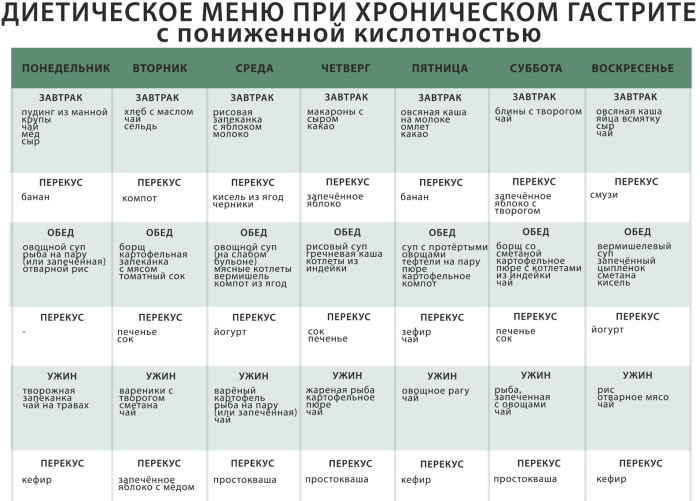
Firstly, this is due to the fact that the disease itself is the result of an improper and unbalanced diet, in which junk food predominated. Secondly, malfunctions in the body from the gastrointestinal tract, pancreas, stomach, etc. rarely go unnoticed. As a rule, gastroduodenitis, if left untreated and neglected by the doctor's recommendations, comes back again.
In the chronic form of the disease, you need to drink abundantly and eat in small portions, excluding foods that can irritate the mucous membranes. This means a complete ban on seasonings and spices, sauces, smoked meats and canned food, mushrooms, as well as fried foods, some cereals (wheat, pearl barley, millet) and raw vegetables.
With exacerbation of gastroduodenitis
When the acute form of the disease has already passed, the patient is recommended to introduce mucous cereals into the diet. It can be cereals or oatmeal, rice or buckwheat porridge (in pureed form). It is very useful to eat slimy and puree soups. You can also introduce lean meat and fish into the diet, but they must be chopped. Food must enter the body at least 5-6 times a day.
It is also important to maintain a drinking balance by introducing jelly, weak and slightly sweet tea or rosehip broth into the diet.
The diet for gastroduodenitis at this stage excludes cocoa and carbonated drinks, sauces and spices, raw fruits and vegetables, confectionery and flour products, and alcohol.
With gastroduodenitis with high acidity
The disease can be accompanied by sluggish motor skills and a decrease in acid production, and vice versa - an increased acid content. The latter form requires special attention, since the abundant production of acid provokes the appearance of erosions on the wall of the stomach, which is fraught with the development of an ulcer. Therefore, the patient is recommended a fractional diet with an equal interval between meals, carried out at the same time. Dishes must be steamed or cooked in the oven, or cooked.
Cooked food should be warm, not hot.
It is necessary to maintain a drinking balance, and drink both compotes and jelly, and juices, tea with milk or a decoction of rose hips.
The diet for gastroduodenitis of this form provides for the inclusion of dairy products and low-fat cheeses, mousses and jellies, pasta and cereals, crackers and biscuits, cooked sausage or ham, mashed soups and baked fruit. Low-fat meats and fish are recommended. From raw and canned vegetables, only green peas and greens are allowed (as an addition to soup).
With erosive gastroduodenitis
Erosive gastroduodenitis involves the formation of erosion on the walls of the stomach and duodenum, therefore the recommended diet for this form of the disease should help eliminate the negative effect on the mucous membrane shell. This means that the food intake should reduce the thermal and chemical effects on the digestive organs.
The goal of this diet is to fill the body with nutrients with the least stomach irritation and fast digestion of food. Food intake should be divided into 6-7 times a day, completely excluding salt and seasonings.
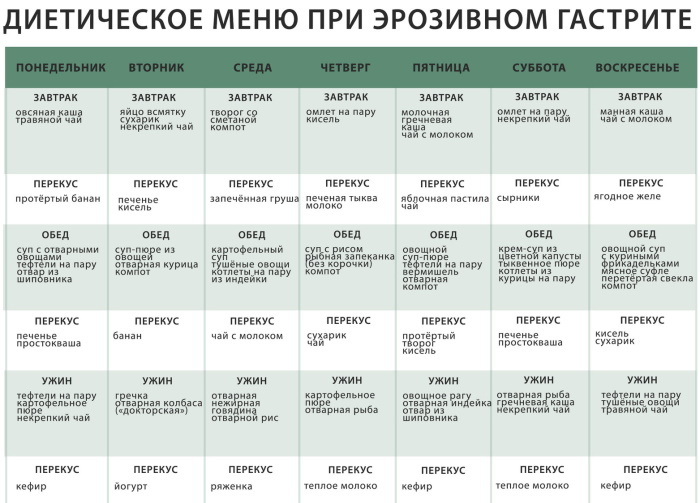
You can eat cottage cheese, non-acidic kefir and cream, slimy cereals and soups, omelets. Meat and fish should be low-fat varieties, they must be carefully chopped and steamed. From vegetables it is required to give preference to pumpkin and beets, carrots and cauliflower. Fruits are allowed only baked.
With superficial gastroduodenitis
This form of the disease develops as a result of gastritis. Most often, the reason for the development of superficial gastroduodenitis is non-observance of the elementary rules of food intake, as well as proper nutrition.
With superficial gastroduodenitis, it is necessary to eat 5 times a day in small portions. To mitigate the course of the disease, as well as its symptoms, the menu should include low-fat cottage cheese and milk, lean meat and fish, boiled vegetables (such as beets and carrots, potatoes and peas), and fruit purees and jelly. Alkaline mineral water and compotes are recommended for drinking. This diet must be followed for at least 3 months.
With atrophic gastroduodenitis
The atrophic form of gastroduodenitis implies a violation of secretion, that is, a decrease in the acidity of gastric juice. With this form of development of the disease, a therapeutic diet is recommended, consisting of yesterday's wheat bread, soups and cereals cooked in weak vegetable or meat broths, fruit purees. Dairy and fermented milk products (except milk), as well as meat and fish are allowed only low-fat. You can add honey and lemon to dishes.
Food should be divided into several meals a day, with solid and liquid meals taken separately at regular intervals.
With pancreatitis and gastroduodenitis
Diseases associated with damage to the digestive system are usually associated with the fact that most people neglect the basic rules of nutrition. With pancreatitis against the background of exacerbation or development of gastroduodenitis, it is necessary to give the pancreas at least 3 days of rest.
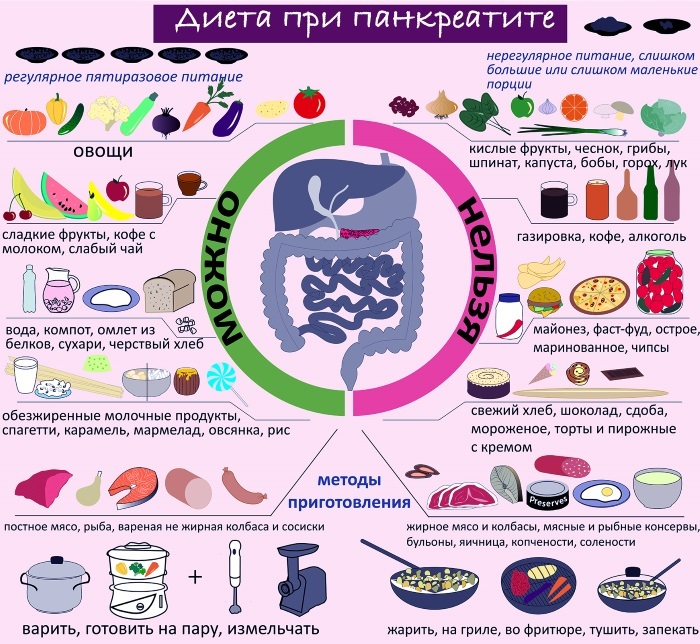
During this period, it is required to drink teas and decoctions, refraining from eating. And only from the fifth day you can add vegetable puree from carrots and potatoes to the menu. Next, you should give preference to mashed soups and dairy products.
With gastritis and gastroduodenitis
Any pronounced form of gastritis and gastroduodenitis requires a sparing diet, refusal from cigarettes and alcoholic beverages, as well as the exclusion of products containing coarse fiber, carbonated drinks, any spices and spices, milk.
Meals should be fractional and at least 5-6 times a day (7-8 is possible). You need to drink about 1500 ml of liquid per day, which can be weak green and black tea with lemon, decoctions of berries and herbs, jelly and compotes. In this case, the calorie content of food per day should be about 2800 kcal. All products should be subjected to any heat treatment, except for frying.
With gastroduodenitis and cholecystitis
When cholecystitis joins gastroduodenitis, gastroenterologists recommend making a diet in such a way as to neutralize excess hydrochloric acid and choleretic effect. Therefore, the diet should include non-acidic fruits, dairy products and vegetable dishes, cottage cheese, boiled meat and fish, carefully thermally processed and mashed.
It is not recommended to eat fresh bread and baked goods, raw eggs and mushrooms, smoked meats and canned food, fatty fish and meat.
Contraindications
Contraindications to the diet, usually recommended for diseases of the stomach and intestines, may be various food intolerances (gluten, lactose, and so on). In such cases, you will need to draw up an individual diet taking into account the permitted food products.
Helpful hints
It is necessary to introduce into the diet as much cottage cheese as possible, as well as other fermented milk products. In addition, lean meat and fish should be eaten, which undergo mild heat treatment, that is, boiling, steaming or stewing. It is important to remember that you cannot fry food.
Soups should be slimy or puree; it is advisable to give preference to rice and buckwheat from cereals. It is undesirable to get carried away with potatoes, despite the fact that its inclusion in the menu is allowed. You can eat yesterday's wheat and, in some cases, rye bread.
Diet monotony can be exhausting for the patient, and this is fraught with breakdown and deviation from dietary requirements. Therefore, you should regularly add something new to the diet. For example, you can make berry mousse, cottage cheese dessert with strawberries, and so on.
By being creative and varying the products allowed for gastroduodenitis, you can not only improve the condition of your body, but also pamper yourself with delicious food.
Main menu
For a sick stomach and intestines, the diet menu may look like this:
- mashed porridge, slimy, liquid (including oat and semolina, rice and buckwheat);
- liquid and puree soups;
- lean meat, carefully chopped;
- lean fish;
- eggs;
- warm drinks in large quantities (compotes and jelly, rosehip broth, slightly sweetened tea).
For example, in the morning you can eat milk porridge and grated cottage cheese with sour cream and sugar, for lunch - baked apples. For lunch, you can serve semolina soup, rice porridge with meat and compote, for an afternoon snack you can drink rosehip broth. In the evening, it is recommended to eat an omelet of 1 egg, vegetable puree with boiled fish and a couple of pieces of marmalade for tea. At night (before going to bed), it is advisable to drink a fermented milk product.
A sample menu for a week might look like this:
| Breakfast | Lunch | Dinner | Afternoon snack | Dinner | |
| Monday | 2 boiled soft-boiled eggs, 2-3 slices of yesterday's bread, tea sweetened with sugar or honey | Crackers and jelly | Rice soup, baked or boiled chicken breast, 100 g of boiled spinach, 2-3 slices of yesterday's white bread | 1-2 baked apples | White rice risotto with carrots, 1-2 boiled chicken legs |
| Tuesday | Omelet of 2 eggs, 2-3 slices of bread, tea sweetened with sugar or honey. | Curd soufflé with strawberries. | Oat soup, pasta with boiled vegetables | Baked quince (without peel). | Boiled chicken leg with 100-150 g of boiled or steamed vegetables (spinach, carrots, potatoes or celery), some boiled white rice or white bread. |
| Wednesday | 2-3 slices of toast with 2 egg omelet (no fat), tea sweetened with sugar or honey. | 1-2 baked pears (without peel) | Vegetable puree soup, white rice with carrots, 1-2 boiled chicken legs. | Simple biscuits or crackers with compote. | 1-2 baked fish fillets with 100-150 g of boiled or stewed vegetables (spinach, carrots or potatoes), white bread. |
| Thursday | Rice milk porridge, 2-3 slices of toast, tea with sugar or honey. | Berry jelly and crackers. | Semolina soup, baked or boiled chicken fillet with boiled vegetables. | Baked quince (without peel). | Buckwheat porridge and steamed turkey cutlets. |
| Friday | half an avocado (very ripe) with 2-3 slices of toast, tea sweetened with sugar or honey | Baked apples. | Buckwheat soup, mashed potatoes in water, baked or boiled chicken breast. | Compote and white bread toasts. | Boiled chicken leg with rice. |
| Saturday | 2 soft-boiled eggs, 2-3 slices of toast, tea sweetened with sugar or honey | Berry mousse. | Vegetable puree soup, steamed turkey cutlets and buckwheat porridge. | Baked quince (without peel). | 1-2 boiled chicken legs and boiled beetroot and carrot puree |
| Sunday | 2 soft-boiled eggs, 2-3 slices of toast, tea sweetened with sugar or honey. | Curd soufflé. | Rice soup, boiled or baked fish fillets and mashed potatoes in the water. | 1-2 baked pears (without peel). | Boiled chicken leg with rice cooked with carrots. |
With exacerbations of gastrointestinal diseases, a diet consisting of liquid and puree food is prescribed. You need to adhere to it for about 2 weeks, after which an improvement is usually observed. Then you should switch to meals according to the requirements of tables No. 1 and No. 5. With a sick stomach and intestines, it is necessary to adhere to these restrictions for at least 2-3 months, despite the disappearance of the main unpleasant symptoms.
Video about nutrition for stomach diseases
Gastrointestinal tract: nutritional rules for problems:


